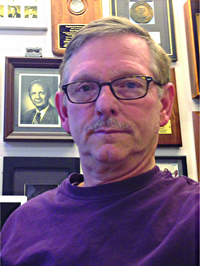This morning’s Pain Pathways in Arthritis symposium will feature a panel of experts who will explain the current understanding of the basic mechanisms of arthritis pain and explore emerging targets for pain management. Because clinical trials targeting nerve growth factor (NGF) are currently ongoing in knee osteoarthritis, there will be a special focus on the biology of this neurotrophin. The symposium will be held from 8:30 – 10:00 am in room 151A.

Among the scheduled presentations, Tony Yaksh, PhD, Professor of Anesthesiology and Pharmacology at the University of California, San Diego, will describe the basic mechanisms of pain pathways in the context of arthritis and joint pain.
“Arthralgia broadly impacts quality of life, and while current therapeutics improve management of the arthritic joint, they may not satisfactorily address the associated pain,” Dr. Yaksh said. “Preclinical models of arthritis of persistent and long-lasting, but reversible inflammation of the joint, display an early-onset pain state that unexpectedly persists long after resolution of the inflammatory indices.”
Importantly, in these persistent cases of joint inflammation there are changes in the properties of sensory neurons that are typically observed after nerve injury, he said. These changes include sprouting within the inflamed joint and, surprisingly, within the sensory ganglion of afferents and sympathetic fibers. These observations, Dr. Yaksh said, suggest a transition from an inflammatory state, wherein spinal and peripheral terminal sensitization is observed, to one with a neuropathic pain phenotype.
“In the preclinical models, we’ve observed that pain behavior in the inflammatory phase responds to nonsteroidal anti-inflammatory drugs (NSAIDs) and agents that block spinal sensitization, while in the post-inflammatory phase, pain only responds to the latter agents,” Dr. Yaksh said. “This is consistent with the development of a neuropathic pain state. Our work shows that this transition from an acute inflammatory state to a neuropathic-like state is mediated by activation of innate immune signaling by the TLR4 gene and lymphocytes. These findings provide directions for the development of therapies regulating the transition from an acute to a chronic pain state.”

Stephen B. McMahon, FMedSci, FSB, Sherrington Professor of Physiology and Director of the London Pain Consortium at King’s College in London, will discuss the biology of nerve growth factor and the rationale and approaches for NGF blockade.
“If you ask patients if they’re satisfied with their pain relief, most of them say that they’re not. That immediately suggests that the cause of the pain has to be something that we’re not treating with various existing drugs,” Dr. McMahon said. “Because the drugs we have don’t work better than they do, that implies that there are other mediators or factors that activate the pain signaling pathway, particularly in persistent injury states.”
In the 1990s, thanks to advances in genetic science, Dr. McMahon and others observed that NGF was commonly upregulated in a number of damaged tissues that were painful in both animal models and humans.
“At that time, we and a number of others began to explore the biology of NGF, and we’ve come to know quite a lot about it,” he said. “We know, for example, that there are receptors for NGF that are highly expressed on the peripheral pain signaling fibers. It turned out that if you gave NGF to those nerve fibers in an experimental context, you could excite and sensitize the nerve fibers. So, there is lots of evidence dating back 20 years that NGF could be a pain mediator.”
In initial clinical trials, monoclonal anti-NGF antibodies showed considerable efficacy in treating the pain related to several disorders, including osteoarthritis. Today, Dr. McMahon said, the first reports are beginning to come out from pivotal final trials exploring the risk of side effect liabilities in these new drugs.
“We know these drugs have fantastic efficacy in people, and while it’s not 100 percent clear whether they will make it to the market because of side effect issues, they are the most promising candidates for a new class of analgesic drug in a long time,” Dr. McMahon said. “For patients who come through their door with pain that we can’t treat, there’s a lot of evidence that these new drugs are going to be very helpful. We’re not quite there yet, but there’s hope for tomorrow.”
Also presenting during this symposium will be Richard J. Miller, PhD, Alfred Newton Richards Professor of Pharmacology at Northwestern University Feinberg School of Medicine in Chicago, who will discuss emerging targets for the management of joint pain.
BASIC SCIENCE TRACK
Pain Pathways in Arthritis
8:30 – 10:00 am Today • Room 151A
